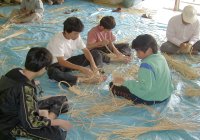|

Traditionally waraji were made from rice straw - a material not readily available in North America. A common substitute is jute, because it is cheap and available. I have not yet made a pair with regular straw, but am planning it for my next pair and will update then.
Materials
If you are using jute, you will need two weights - one that is approximately 2 cm (3/4 in) in diameter, and one that is sligtly thinner that a pencil. If you are using straw to weave your sandals, you will need a thick rope to weave around - either jute or straw rope.
In Japan, the thick rope is looped around your big toes to hold the rope in place as you begin to weave (see illustration). If this is not a method you would like to use, you will need to construct a "toe board". This is done by taking a length of plank - at least long enough to fit your foot plus 5 cm (2 in) and placing pegs or nails to hold the rope as you weave. To do this, place your foot on the board with some space above and below your foot, then mark where the toe and heel end. Mark 2 cm (3/4 in) from the toe height. This is the height where you will place the pegs. You will need 4 pegs, placed (left to right) peg - 2 cm - peg - 4 cm - peg - 2 cm - peg. This is the distance is variable, depending on the exact diameter of your rope. (Note: you need thin pegs - nails or craft pegs. cut pieces of dowel are too thick.) 
Getting Started
Set up your thick rope as shown, with the loops over your toes or between the pegs. When setting up your rope, you will need to adjust it to the proper size for your foot. The Japanese idea of a well fitting shoe is very different from the Western idea - the thong part of the sandals will be at the very front of the sandals, so your toes will actually be hanging off the end. Your heel should come right to the end of the sandal, without coming over the end. (Note: this sizing is for this type of waraji. Sizing geta, for instance is different - it is ok to have your heel hanging slightly over the back of geta.) Bend your cord as shown, so the ends are just short enough to fit comfortably inside the big loop at the bottom. Once you have this sized properly to your foot, you can begin weaving the main part of the sandal.
Finnishing
Straw sandals will only last 3 to 4 days of wear. Jute sandals can make it through Pennsic alive (1 to 2 weeks), but that will be the end of them. There are several methods that can be used to prolong the life of your sandals, such as coating the bottom with glue, adding a rubber sole, ect. Experiment with different materials to see what works for you. Waraji can also be very slippery on gym floors, so you may want to add some sort of sole for this reason, particularly if you intent to fight in waraji. (Some kingdoms do not allow you to fight in sandals, contact your Earl Marshal from more information.)
|

